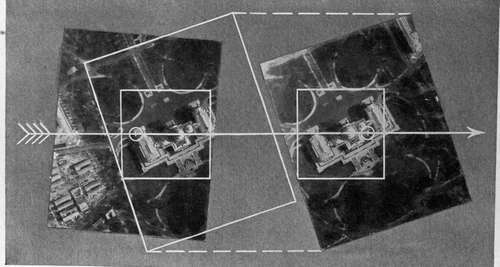The Mounting Of Aerial Stereograms
Description
This section is from the book "Airplane Photography", by Herbert E. Ives. Also available from Amazon: Airplane photography.
The Mounting Of Aerial Stereograms
The first step in making the printed stereogram is to select two pictures taken on the same scale, but from slightly different positions. These may be two chosen from a collection made for other purposes, or else a pair taken at distances calculated to fit them for stereoscopic use. The next step is to mark the center of each picture, either with easily removed chalk or witn a pin point. They are then superposed, and afterward carefully moved apart by a motion parallel to the line joining their centers when superposed. The final step before mounting is to mark out and cut the two elements, their bases being parallel to the line of centers, their horizontal length the distance between the optic axes of the stereoscope (or as near this as the size of the prints will permit). They are then mounted on a card, with their centers separated by approximately 65 millimeters. The right-hand view is the one showing more of the right-hand side of objects, and vice versa. This process of arranging, cutting, and mounting is shown clearly in Fig. 160. In this case the stereoscopic elements lie symmetrically about the line joining the centers of the original prints. This is not necessary, as they may be selected from above or below this line so long as their bases are parallel to it. A simplification of this method consists in superposing the two prints, laying over them a square of glass of the size to which they are to be cut, then turning it so that a side is parallel to the line of centers, and cutting around it through both prints with a sharp knife. The principle and results are of course the same with both methods.
If large numbers of stereoscopic prints are required it is necessary, for economy of time, either to photograph a finished stereogram and make prints from this copy negative, or to set up special printing machines. Under the general discussion of printing devices a stereoscopic printer is described (the Richard) in which the two negatives are placed so that stereo prints can be got by two successive printings on one sheet of paper.

Fig. 160. - Method or arranging stereoscopic prints for cutting.
Continue to:
Tags
camera, lens, airplane, aerial, film, exposure, photography, maps, birdseye
